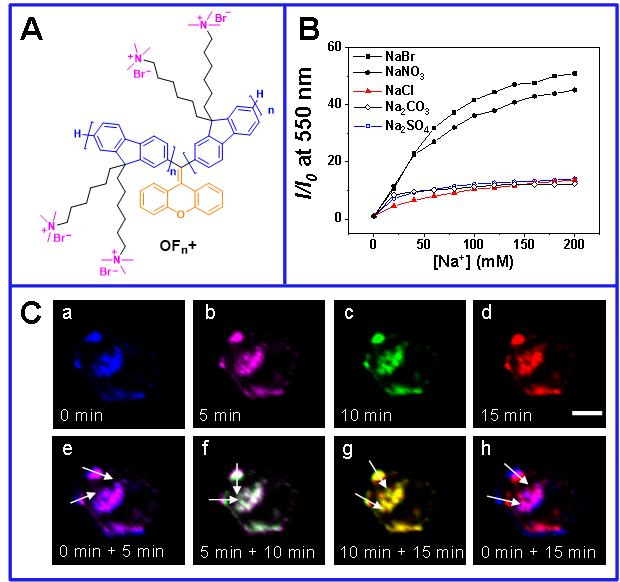On March 14th,Chemical Communications published the latest research results of Prof. Zhu Mingqiang's team at Wuhan National Laboratory for Optoelectronics, “Geminal cross-coupling synthesis, ion-induced emission and lysosome imaging of cationic tetraarylethene oligoelectrolytes”.
Aggregation of induced emission (AIE) materials has effectively solved the problem of aggregate fluorescence quenching (ACQ), which has become an important research topic and has been widely used in chemosensors, bioprobes, immunoassay markers and bioimagings. In these applications, it is required that the used AIE material should be hydrophilic or even water-soluble. However, tetraphenylethene (TPE) and other typical AIE-active materials are naturally hydrophobic, which has limit the practical applications as they are easy to aggregate in water. Introduction of ionic group of the structure of DTE is a great way to realize the water solubility. Unfortunately, due to limit of traditional synthesis methods, the reported TPE-derivatives did not have a big change on the core structure of TPE, which brings limited optical properties or functions of these traditional type TPE derivatives.

Fig. 1 (A) The structure of OFn+. (B) The enhancement of emission peak intensity at 550 nm versus Na+ concentration [Na+] with various anions. (C) Confocal images of a HeLa cell stained with 5.0 µM OF1+ and stimulated using 5 µM chloroquine. Different pseudocolors are used to display the fluorescence images at different stimulation times: (a) 0 min, (b) 5 min, (c) 10 min, (d) 15 min; Merged images at two different moments: (e) 0 min and 5 min, (f) 5 min and 10 min, (g) 10 min and 15 min and (h) 0 min and 15 min. The white arrows in (e)-(h) are used to trace the movement direction of lysosome. Scale bar = 5 µm.
In this work, by means of GCC, we have designed and synthesized a series of cationic conjugated oligoelectrolytes OFn+ (n = 1-3). (Fig. 1A) An interesting discovery for these hydrophilic cationic oligoelectroytes is that OFn+ (n = 1-3) exhibit strong salt or ionic effect. The fluorescence intensity gradually increases as the ion concentration increases. (Fig. 1B)
In the molecular structure of OFn+ (n = 1-3), the 9-C position of each fluorene is replaced by a pair of six-carbon hydrophobic alkyl chains containing positively charged, quaternary ammonium head groups which will interact with anionic cell membrane, intercalate into the cell membrane and increase the membrane permeability by distorting the arrangement of membrane phospholipids. OFn+ (n = 1-2) exhibit excellent colocalization to lysosomes of living HeLa cells, which are also used for fluorescence imaging and tracing of lysosome events. (Fig. 1C)
The main contribution of this article is the design concept of sythesizing hydrosoluble tetraarylethene (TAE) dyes with ions-induced emmission effect and lysosome targeting ability by GCC reaction, which has a great guiding significance for the design of various specially functional AIE compounds in the future.
This work was completed by Qi-Yuan Zhou,# Bo Xin,# Ya-Long Wang,# Chong Li* and Ming-Qiang Zhu* (# contributed equally,*the corresponding authors) from the Energy Photonics Functional Laboratory of Wuhan National Center for Optoelectronics. This work was supported by the National Basic Research Program (973) of China, the National Natural Science Foundation of China, the Fundamental Research Funds for Central Universities, and the Director Fund of WNLO (2016).
Full text link: http://pubs.rsc.org/en/content/articlelanding/2018/cc/c8cc00533h#!divAbstract